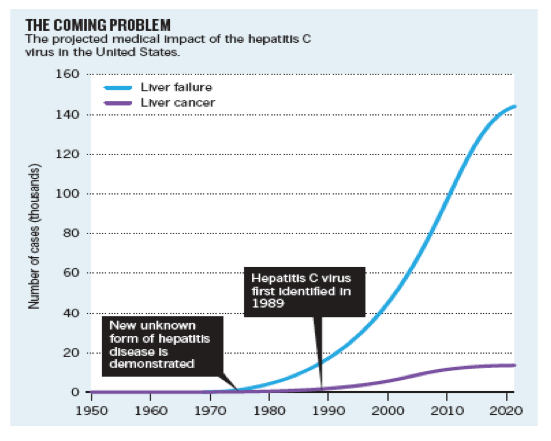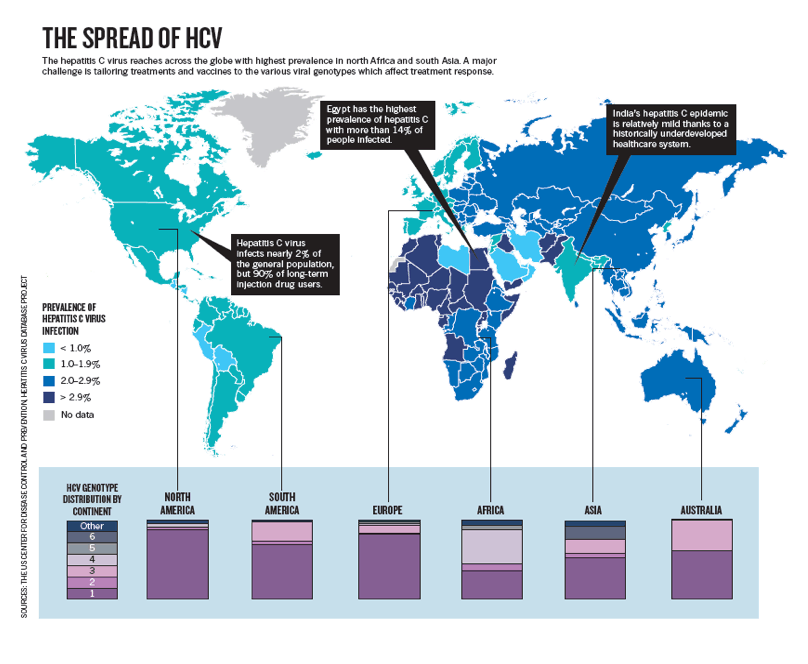| |
Hepatitis C, A smouldering public-health crisis, 'Silent Epidemic' in U.S. Needs More Funding, Researcher Says
|
| |
| |
Long overshadowed by HIV, the hepatitis C virus is starting to take its toll. And the heat is on to find and treat those affected.
Nature HCV Supplement
Global HCV - (12/01/11)..... Soon HCV cure rates will be 100% in genotypes 1, 2 and 3 in clinical studies with the advent of new HCV drugs, how will this evolve globally?
Some 130-200 million people are now estimated to be infected worldwide. But 75% in the USA with HCV are untested & therefore undiagnosed. The CDC estimates that about 80% of HIV-infected people in the United States know they have the disease, but the figure for HCV awareness is about 30%. More than 50 other drugs are in the research and development pipeline . The hepatitis C virus is endemic among injection drug users, who could harbour treatment-resistant viruses. We need to adapt to this reality, says Diana Sylvestre, "It is time that regulators, pharmaceutical companies and healthcare workers come to terms with the fact that many patients with HCV are injection drug users".
Hepatitis C is just as deadly as HIV - both kill about 10,000-15,000 people per year in the United States, according to David Thomas, an infectious diseases specialist at Johns Hopkins Bloomberg School of Public Health in Baltimore, Maryland. But HIV gets about 30 times more research funding in the United States than HCV, he says. And as increasing numbers of chronic hepatitis C cases manifest their most serious symptoms, the smouldering problem is turning into a burning public-health issue that threatens to stretch researchers, patients, and the health-care system to their limits.
People at the highest risk of the HCV are among the most marginalized groups in society, such as injection drug users, prisoners and those living in endemic regions of the developing world. In parts of Asia and Africa, up to 10% of the population is infected with HCV; in Egypt, the prevalence of anti-HCV antibodies is as high as 15%.
FREE FROM INTERFERON
There is also hope for patients who are not responsive to - or cannot tolerate - the backbone of triple therapy: interferon. This April at the International Liver Congress, Anna Lok, a hepatologist at the University of Michigan in Ann Arbor, presented data from a small phase IIa study of an interferon-free regimen in null responders. The study comprised patients on double therapy consisting of two classes of direct-acting antiviral: Bristol-Myers Squibb's BMS-650032 (a protease inhibitor) and BMS-790052 (an NS5A inhibitor). These patients were compared with a cohort taking quadruple therapy, consisting of these two antivirals plus interferon-α and ribavirin. The quadruple therapy suppressed HCV in 10 out of 10 patients for at least 12 weeks after treatment, whereas the interferon-free double therapy suppressed HCV in 4 out of 11 patients, with 6 being null or partial responders. At this year's Liver Meeting AASLD, Nov 2011, 100% of HCV+ genotype 2/3 patients were cured with an interferon free 2 drug regimen of nucleotide PSI-7977+ribavirin, in a small number of patients, 30.
"HCV is transmitted through the blood, mainly via transfusions, shared needles and reused medical supplies. Sexual and mother-to-child transmission is much less likely than for HIV. In developed nations, most new infections occur in injection-drug users. An estimated 1.6% of the US population carries HCV, as many as three-quarters of whom don't know they have it3. In poorer countries, the reuse of medical supplies is still common and - in combination with a lack of screening of blood donations - is fuelling the virus's spread. Complicating the picture, HCV exists in at least eleven variations or at lest six genotypes, and treatment success varies by genotype. (see 'Spread of HCV').
Different countries confront distinct challenges when dealing with the HCV epidemic. The Egyptian healthcare system, for instance, has to cope with the highest rate of transmission in the world, at least 14% of Egypt's citizens infected - three times the global infection rate (see 'A uniquely Egyptian epidemic', page S12). Elsewhere, severity of the HCV epidemic is obscured by other, more immediately severe public health concerns. Throughout much of Africa, HCV 'hides behind' widespread HIV and hepatitis B virus infections, says virologist Jean-Michel Pawlotsky, director of the French National Reference Center for Hepatitis B, C and delta. On a recent visit to a country in southern Africa, Pawlotsky noticed that they screen blood for HIV and hepatitis B but that "they don't have the resources" to screen for HCV.
"All countries share a few common challenges with hepatitis C," says John Ward, director of the viral hepatitis program at the US Centers for Disease Control and Prevention. "One is a very low level of awareness of the severity of the problem - clinician knowledge of HCV seems to be inadequate no matter what country you're in."
Even when a country is acutely aware of its HCV problem, the best available options are barely adequate to the task. In France, where politicians were found guilty of distributing HIV-contaminated blood in the mid-1980s, officials are now trying to prevent a repeat with HCV. French public-health workers have been screening the populace intensively for HCV, and the French government estimates that it has identified 60% of the country's infected citizens, Pawlotsky says. "Half of those have been treated, and half of those treated have been cured." Which, he says, means that "with the heaviest campaign worldwide and the largest proportion of screened patients, we have only cured twelve to fifteen percent" of those infected nationwide."
Hepatitis C 'Silent Epidemic' in U.S. Needs More Funding, Researcher Says
By Meg Tirrell
Bloomberg, May 25, 2011
Hepatitis C, a disease that affects at least 5 million Americans, may be growing at a greater rate than reported as a "silent epidemic" of the virus spreads among younger people, according to a New York epidemiologist.
Inadequate U.S. government funding for prevention, treatment and research have contributed to the growing public health problem, said Brian Edlin, a professor at the State University of New York Downstate College of Medicine in Brooklyn, in an editorial published today in the journal Nature.
Viral hepatitis will cause about 150,000 deaths in the U.S. in the next decade as the population of patients with the disease ages, Edlin wrote. Increased use of injected drugs among 15- to 25-year-olds has unleashed a new wave of hepatitis C among young people, he said. Injected drug users, the group most likely to have new infections, rarely experience symptoms after acquiring the liver disease and are therefore unlikely to seek medical care and report its transmission, Edlin said
"Hepatitis C has been sort of a quiet epidemic," Edlin said in a telephone interview, calling in the editorial for "urgent investment" similar to moves against HIV. "There hasn't been the political pressure exerted to garner the necessary support for resources to be committed to it."
The Centers for Disease Control and Prevention estimates there are 20 new infections for each case reported to its surveillance system, he wrote. About 18,000 people may be newly infected annually, about one person every 30 minutes, the CDC estimates suggest.
'Ten Times'
"It could be double that or 10 times that and we just don't know," Edlin said, citing government surveillance systems that don't account for "disenfranchised" populations such as homeless people and prisoners. "We have no way of knowing how many of these infections are occurring."
In its action plan published this month on viral hepatitis, the U.S. Department of Health and Human Services didn't include an intention to increase funding for the disease, a necessary action to limit its spread, Edlin said.
The action plan "will offer an unprecedented opportunity to provide Americans, particularly those in vulnerable and underserved populations, with improved viral hepatitis prevention, care, and treatment services," said Howard K. Koh, assistant secretary for health at HHS. "However, the federal government cannot do this alone. The prevention, care, and treatment of viral hepatitis will require leadership at all levels of government and full engagement of community-based organizations and the private sector to effectively address the extraordinary challenges we face with this silent epidemic."
More Testing
The U.S. should advocate providing hepatitis C testing wherever HIV tests are available, increase prevention efforts such as needle-exchange facilities and counseling, and prioritize research into therapies to improve care, Edlin said. The disease usually spreads through contact with infected blood. At least half of patients with hepatitis C could be cured with a course of therapy over six to 12 months, with new drugs expected to be more effective, he said.
This month, Merck & Co., of Whitehouse Station, New Jersey, won approval for the first hepatitis C drug in almost a decade, followed by clearance for another new medicine from Vertex Pharmaceuticals Inc. (VRTX), based in Cambridge, Massachusetts. A drug cocktail that has been the standard hepatitis C therapy for the last decade requires 48 weeks of treatment and fails in about half of patients. Clinical trials showed the new drugs cured more patients in less time when used with approved treatments.
AIDS Fight
Government organizations should bring the same focus to hepatitis C as they brought to the fight against HIV, Edlin said. He estimated the CDC allocated less than $10 million each for hepatitis C and B in its 2010 prevention budget, compared with $728 million for HIV, even though five times as many people are infected with hepatitis C as with HIV, according to his editorial.
"The United States launched a vibrant response to the HIV/AIDS epidemic and made great advances in surveillance, prevention, care and treatment by investing in research and services in these areas," he wrote. "A timely, proportionate response to HCV will require leadership and resources. Nothing less will mitigate the extraordinary toll that viral hepatitis could take on the public's health and on the health-care system."
Nature HCV Supplement
www.natap.org/2011/newsUpdates/060911_01.htm
Nature HCV Supplement. Download the pdf here. Supplement Hepatitis C Vol. 474 No. 7350_supp S1-S48. nature.gif. · In this Supplement · Infecting



|
|
| |
| |
|
|
|